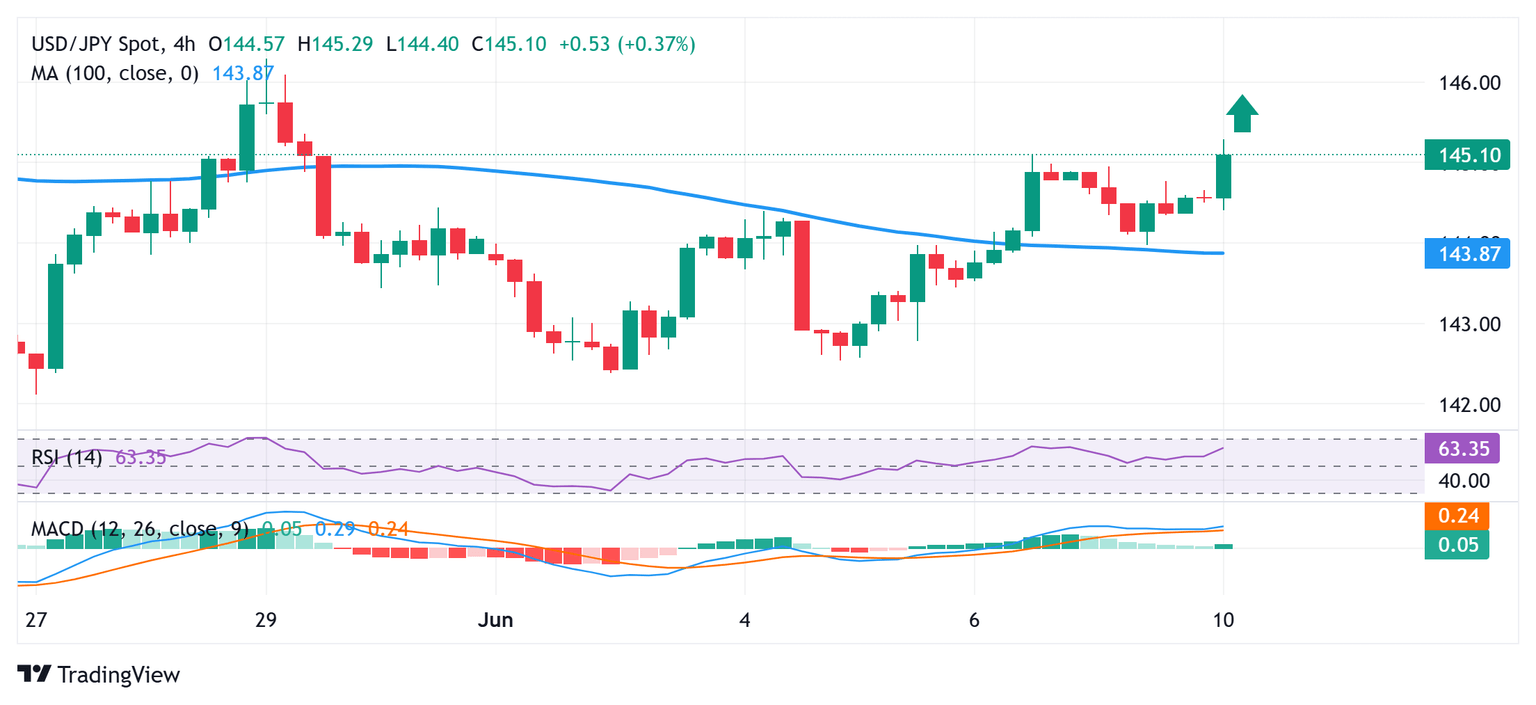Japanese Yen climbs to intraday high; USD/JPY downside seems limited amid modest USD strength
- The Japanese Yen attracts some dip-buyers on Tuesday amid reviving safe-haven demand.
- The divergent BoJ-Fed policy expectations further benefit the JPY and cap the USD/JPY pair.
- US fiscal concerns keep the USD depressed near a multi-week low and weigh on spot prices.

The Japanese Yen (JPY) rebounds from a nearly two-week low touched against its American counterpart earlier this Tuesday and turns positive for the second straight day heading into the European session. The market nervousness ahead of the second day of US-China trade talks helps revive demand for traditional safe-haven assets. Apart from this, the growing acceptance that the Bank of Japan (BoJ) will hike interest rates again assists the JPY in attracting some dip-buyers.
The US Dollar (USD), on the other hand, continues with its struggle to attract any meaningful buyers and remains confined in a familiar range held over the past week or so amid US fiscal concerns. Adding to this, bets that the Federal Reserve (Fed) will lower borrowing costs further this year act as a headwind for the USD. Meanwhile, the divergent Fed-BoJ expectations turn out to be another factor benefiting the lower-yielding JPY and exerting downward pressure on the USD/JPY pair.
Japanese Yen bulls look to regain control amid reviving safe-haven demand, hawkish BoJ expectations
- Top US and Chinese officials will meet for a second day in London on Tuesday for negotiations aimed at resolving the ongoing trade dispute between the world’s two largest economies. Investors remain hopeful of a breakthrough over export controls for goods, such as rare earths, which remains supportive of a positive risk tone and undermined the safe-haven Japanese Yen earlier this Tuesday.
- Data released on Monday showed that Japan's economy contracted at a slower pace than initially estimated, by 0.2% annualized rate during the January-March quarter, sparking optimism about the outlook. This, in turn, reaffirms market bets that the Bank of Japan will continue normalizing rates amid sticky inflation and assists the JPY to attract some dip-buyers heading into the early European session.
- BoJ Governor Kazuo Ueda said on Tuesday that the central bank will raise interest rates if it has enough confidence that the underlying inflation nears 2% or moves around 2%. If the economy and prices come under strong downward pressure, the central bank has limited room to underpin growth with interest rate cuts, with short-term rate still at 0.5%, Ueda added further.
- A stronger-than-expected US Nonfarm Payrolls (NFP) report released on Friday dampened hopes for imminent interest rate cuts by the Federal Reserve this year. This assists the US Dollar to regain positive traction following the previous day's modest slide and pushes the USD/JPY pair back closer to the 145.00 psychological mark during the Asian session on Tuesday.
- Traders, however, are still pricing in a greater chance that the US central bank will lower borrowing costs in September. Furthermore, Trump intensified his pressure campaign and urged Fed Chair Jerome Powell to cut rates by a full percentage point. This, along with concerns about the US government's financial health, might cap further USD appreciation.
- According to Ukraine's air force, Russia launched a massive airstrike on Ukraine and fired nearly 500 drones and missiles, marking a further escalation of the conflict in the three-year-old war. This keeps geopolitical risks in play, which should hold back the JPY bears from placing aggressive bets and act as a headwind for the USD/JPY pair ahead of US inflation figures.
USD/JPY could accelerate the corrective slide once the seems poised to add to its intraday gains; breakout above 100-hour SMA in play

From a technical perspective, the overnight bounce from sub-144.00 levels, or the vicinity of 100-hour Simple Moving Average (SMA), and the subsequent move up favors the USD/JPY bulls. Moreover, oscillators on the daily chart have just started gaining positive traction, suggesting that the path of least resistance for spot prices is to the upside. Hence, some follow-through strength towards the 145.60-145.65 intermediate hurdle, en route to the 146.00 round figure, looks like a distinct possibility. The momentum could extend further towards the 146.25-146.30 region, or May 29 swing high.
On the flip side, any further decline is likely to find decent support near the 144.25 area (200-period SMA on the 4-hour chart), below which the USD/JPY pair could retest sub-144.00 levels. The latter should act as a key pivotal point, which if broken decisively would negate the positive outlook and shift the near-term bias in favor of bearish traders.
Tariffs FAQs
Tariffs are customs duties levied on certain merchandise imports or a category of products. Tariffs are designed to help local producers and manufacturers be more competitive in the market by providing a price advantage over similar goods that can be imported. Tariffs are widely used as tools of protectionism, along with trade barriers and import quotas.
Although tariffs and taxes both generate government revenue to fund public goods and services, they have several distinctions. Tariffs are prepaid at the port of entry, while taxes are paid at the time of purchase. Taxes are imposed on individual taxpayers and businesses, while tariffs are paid by importers.
There are two schools of thought among economists regarding the usage of tariffs. While some argue that tariffs are necessary to protect domestic industries and address trade imbalances, others see them as a harmful tool that could potentially drive prices higher over the long term and lead to a damaging trade war by encouraging tit-for-tat tariffs.
During the run-up to the presidential election in November 2024, Donald Trump made it clear that he intends to use tariffs to support the US economy and American producers. In 2024, Mexico, China and Canada accounted for 42% of total US imports. In this period, Mexico stood out as the top exporter with $466.6 billion, according to the US Census Bureau. Hence, Trump wants to focus on these three nations when imposing tariffs. He also plans to use the revenue generated through tariffs to lower personal income taxes.
Author

Haresh Menghani
FXStreet
Haresh Menghani is a detail-oriented professional with 10+ years of extensive experience in analysing the global financial markets.

















